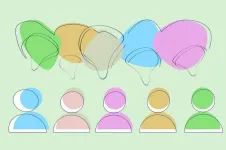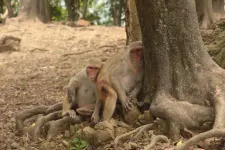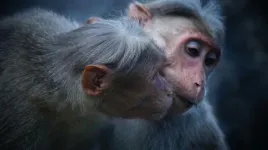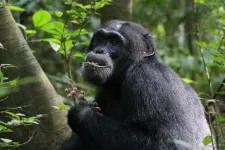(Press-News.org) Key takeaways
Iron meteorites are remnants of the metallic cores of the earliest asteroids in our solar system. Iron meteorites contain refractory metals, such as iridium and platinum, that formed near the sun but were transported to the outer solar system.
New research shows that for this to have happened, the protoplanetary disk of our solar system had to have been doughnut-shaped because the refractory metals could not have crossed the large gaps in a target-shaped disk of concentric rings.
The paper suggests that the refractory metals moved outward as the protoplanetary disk rapidly expanded, and were trapped in the outer solar system by Jupiter.
Four and a half billion years ago, our solar system was a cloud of gas and dust swirling around the sun, until gas began to condense and accrete along with dust to form asteroids and planets. What did this cosmic nursery, known as a protoplanetary disk, look like, and how was it structured? Astronomers can use telescopes to “see” protoplanetary disks far away from our much more mature solar system, but it is impossible to observe what ours might have looked like in its infancy — only an alien billions of light years away would be able to see it as it once was.
Fortunately, space has dropped a few clues — fragments of objects that formed early in solar system history and plunged through Earth’s atmosphere, called meteorites. The composition of meteorites tells stories of the solar system’s birth, but these stories often raise more questions than answers.
In a paper published in Proceedings of the National Academy of Sciences, a team of planetary scientists from UCLA and Johns Hopkins University Applied Physics Laboratory reports that refractory metals, which condense at high temperatures, such as iridium and platinum, were more abundant in meteorites formed in the outer disk, which was cold and far away from the sun. These metals should have formed close to the sun, where the temperature was much higher. Was there a pathway that moved these metals from the inner disk to the outer?
Most meteorites formed within the first few million years of solar system history. Some meteorites, called chondrites, are unmelted conglomerations of grains and dust left over from planet formation. Other meteorites experienced enough heat to melt while their parent asteroids were forming. When these asteroids melted, the silicate part and the metallic part separated due to their difference in density, similar to how water and oil don’t mix.
Today, most asteroids are located in a thick belt between Mars and Jupiter. Scientists think that Jupiter’s gravity disrupted the course of these asteroids, causing many of them to smash into each other and break apart. When pieces of these asteroids fall to Earth and are recovered, they are called meteorites.
Iron meteorites are from the metallic cores of the earliest asteroids, older than any other rocks or celestial objects in our solar system. The irons contain molybdenum isotopes that point toward many different locations across the protoplanetary disk in which these meteorites formed. That allows scientists to learn what the chemical composition of the disk was like in its infancy.
Previous research using the Atacama Large Millimeter/submillimeter Array in Chile has found many disks around other stars that resemble concentric rings, like a dartboard. The rings of these planetary disks, such as HL Tau, are separated by physical gaps, so this kind of disk could not provide a route to transport these refractory metals from the inner disk to the outer.
The new paper holds that our solar disk likely didn’t have a ring structure at the very beginning. Instead, our planetary disk looked more like a doughnut, and asteroids with metal grains rich in iridium and platinum metals migrated to the outer disk as it rapidly expanded.
But that confronted the researchers with another puzzle. After the disk expansion, gravity should have pulled these metals back into the sun. But that did not happen.
“Once Jupiter formed, it very likely opened a physical gap that trapped the iridium and platinum metals in the outer disk and prevented them from falling into the sun,” said first author Bidong Zhang, a UCLA planetary scientist. “These metals were later incorporated into asteroids that formed in the outer disk. This explains why meteorites formed in the outer disk – carbonaceous chondrites and carbonaceous-type iron meteorites – have much higher iridium and platinum contents than their inner-disk peers.”
Zhang and his collaborators previously used iron meteorites to reconstruct how water was distributed in the protoplanetary disk.
“Iron meteorites are hidden gems. The more we learn about iron meteorites, the more they unravel the mystery of our solar system’s birth,” Zhang said.
END
Iron meteorites hint that our infant solar system was more doughnut than dartboard
Fragments from the early cosmos help unravel the mystery of our solar system’s birth
2024-06-20
ELSE PRESS RELEASES FROM THIS DATE:
Anti-trust regulators should consider their options carefully when start-ups are acquired, new study suggests
2024-06-20
June 20, 2024
Anti-Trust Regulators Should Consider Their Options Carefully When Start-Ups are Acquired, New Study Suggests
Less Blunt Options than Banning Acquisitions May Help Preserve Innovation and Competition
Toronto - Promoting a competitive marketplace has been the main focus for regulators concerned with “killer acquisitions” -- when big companies swallow small startups to eliminate a potential rival.
But researchers and other observers point out that blocking these purchases puts something else important at risk – innovation. Startups are sometimes driven to come up with a new process or product precisely because ...
Family conditions may have more of an impact on upward social mobility than gender inequality
2024-06-20
Family conditions—specifically, how similar one’s social status and background is to one’s parents’ status—may play a bigger role in determining how easily an individual can shift into a wealthier socioeconomic class than gender inequality, according to a study of 153 countries published June 20, 2024 in the open-access journal PLOS ONE by Khanh Duong from Maynooth University, Ireland.
As global inequality increases, researchers have found that countries with higher levels of income inequality tend to experience lower rates of class mobility (in other words, individuals in a lower socioeconomic ...
People with higher weight, and those who have high-quality experiences with higher-weight people, report less weight bias, per social psychology study of US adults
2024-06-20
People with higher weight, and those who have high-quality experiences with higher-weight people, report less weight bias, per social psychology study of US adults
###
Article URL: https://journals.plos.org/plosone/article?id=10.1371/journal.pone.0305080
Article Title: The role of social norms, intergroup contact, and ingroup favoritism in weight stigma
Author Countries: USA
Funding: The authors received no specific funding for this work. END ...
In two separate clinical studies, combined immunotherapy approach enhances cancer patient response
2024-06-20
Because not all cancer patients respond to a leading type of cancer immunotherapy drug, known as an immune checkpoint inhibitor, scientists explored whether adding janus kinase (JAK) inhibitors – drugs that treat chronic inflammation – could help. In two separate clinical studies, researchers found that adding JAK inhibitors did improve patients’ responses to cancer checkpoint inhibitor immunotherapies. “Aside from the exciting findings of the early phase trials reported by [both groups], they provide a great deal of data with complex analyses of immune ...
Airborne mapping reveals roles for biogenic sources and temperature in air pollution emissions in Los Angeles
2024-06-20
Airborne observations over California have revealed that biogenic sources of volatile organic compounds (VOCs) – blooming trees and growing plants – dominate summertime air pollutant formation in Los Angeles, in a way that increases with temperature. Future air pollution regulations thus need to consider that only 40% of urban VOC emissions (those not tied to biogenic sources) can be mitigated through regulations, say the authors. Ambient air pollution – the fourth-leading global ...
Old bombs reveal new insights: Plants store more carbon, but for a shorter time frame, than we thought
2024-06-20
Analysis of radiocarbon produced during nuclear bomb testing in the 1960s suggests that current Earth system models underestimate carbon uptake into terrestrial vegetation and soils. But, say the study’s authors, this storage is more short-lived than previously thought. The findings suggest that anthropogenic carbon dioxide will not reside as long in the terrestrial biosphere as models currently predict. Accurate climate predictions, crucial for developing effective climate policies, require a robust representation of the global carbon cycle. It’s thought that vegetation and soils account for taking up approximately 30% of anthropogenic carbon dioxide (CO2) ...
The time it takes a person to decide can predict their preference
2024-06-20
Researchers led by Sophie Bavard at the University of Hamburg, Germany, found that people can infer hidden social preferences by observing how fast others make social decisions. Publishing June 20th in the open-access journal PLOS Biology, the study shows that when someone knows the options being considered by another person, and they know how long it takes them to reach their decisions, they can use this information to predict the other person’s preference, even if they do not know what the actual choices were.
How do we know what someone’s social preferences ...
Hurricane changed ‘rules of the game’ in monkey society
2024-06-20
A devastating hurricane transformed a monkey society by changing the pros and cons of interacting with others, new research shows.
Hurricane Maria hit Puerto Rico in 2017, killing more than 3,000 people. It also destroyed 63% of vegetation on Cayo Santiago (also known as Monkey Island), which is home to a population of rhesus macaques.
Even now, tree cover remains far below pre-hurricane levels and – in this hot part of the world – that makes shade a scarce and precious resource for the macaques.
The new study, led by the universities of Pennsylvania and Exeter and published in the journal Science, shows the storm ...
Researchers widely observe yet seldom publish about same-sex sexual behavior in primates and other mammals - often because it is perceived to be rare
2024-06-20
Researchers widely observe yet seldom publish about same-sex sexual behavior in primates and other mammals - often because it is perceived to be rare
###
Article URL: https://journals.plos.org/plosone/article?id=10.1371/journal.pone.0304885
Article Title: Same-sex sexual behaviour among mammals is widely observed, yet seldomly reported: Evidence from an online expert survey
Author Countries: Canada, USA
Funding: The authors received no specific funding for this work. END ...
Wild chimpanzees seek out medicinal plants to treat illness and injuries
2024-06-20
Chimpanzees appear to consume plants with medicinal properties to treat their ailments, according to a study publishing on June 20 in the open-access journal PLOS ONE by Elodie Freymann from the University of Oxford, UK, and colleagues.
Many plants produce compounds that have medicinal effects on humans and other animals. Wild chimpanzees eat a variety of plant matter, including some that is nutritionally poor but may treat or lessen the symptoms of illness. However, it is hard to determine whether chimpanzees self-medicate, by intentionally seeking out plants with properties that help their specific ailments, or passively consume plants ...
LAST 30 PRESS RELEASES:
New software sheds light on cancer’s hidden genetic networks
UT Health San Antonio awarded $3 million in CPRIT grants to bolster cancer research and prevention efforts in South Texas
Third symposium spotlights global challenge of new contaminants in China’s fight against pollution
From straw to soil harmony: International team reveals how biochar supercharges carbon-smart farming
Myeloma: How AI is redrawing the map of cancer care
Manhattan E. Charurat, Ph.D., MHS invested as the Homer and Martha Gudelsky Distinguished Professor in Medicine at the University of Maryland School of Medicine
Insilico Medicine’s Pharma.AI Q4 Winter Launch Recap: Revolutionizing drug discovery with cutting-edge AI innovations, accelerating the path to pharmaceutical superintelligence
Nanoplastics have diet-dependent impacts on digestive system health
Brain neuron death occurs throughout life and increases with age, a natural human protein drug may halt neuron death in Alzheimer’s disease
SPIE and CLP announce the recipients of the 2025 Advanced Photonics Young Innovator Award
Lessons from the Caldor Fire’s Christmas Valley ‘Miracle’
Ant societies rose by trading individual protection for collective power
Research reveals how ancient viral DNA shapes early embryonic development
A molecular gatekeeper that controls protein synthesis
New ‘cloaking device’ concept to shield sensitive tech from magnetic fields
Researchers show impact of mountain building and climate change on alpine biodiversity
Study models the transition from Neanderthals to modern humans in Europe
University of Phoenix College of Doctoral Studies releases white paper on AI-driven skilling to reduce burnout and restore worker autonomy
AIs fail at the game of visual “telephone”
The levers for a sustainable food system
Potential changes in US homelessness by ending federal support for housing first programs
Vulnerability of large language models to prompt injection when providing medical advice
Researchers develop new system for high-energy-density, long-life, multi-electron transfer bromine-based flow batteries
Ending federal support for housing first programs could increase U.S. homelessness by 5% in one year, new JAMA study finds
New research uncovers molecular ‘safety switch’ shielding cancers from immune attack
Bacteria resisting viral infection can still sink carbon to ocean floor
Younger biological age may increase depression risk in older women during COVID-19
Bharat Innovates 2026 National Basecamp Showcases India’s Most Promising Deep-Tech Ventures
Here’s what determines whether your income level rises or falls
SCIE indexation achievement: Celebrate with Space: Science & Technology
[Press-News.org] Iron meteorites hint that our infant solar system was more doughnut than dartboardFragments from the early cosmos help unravel the mystery of our solar system’s birth




